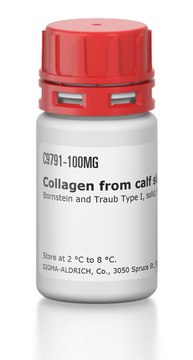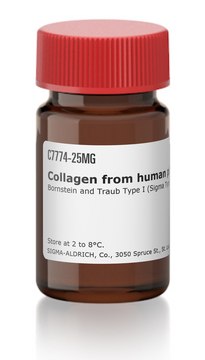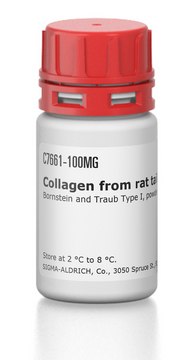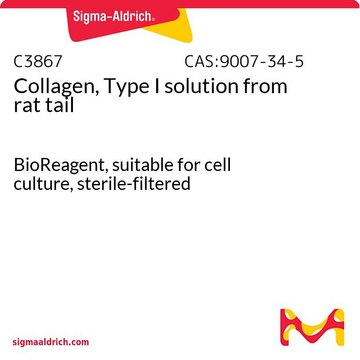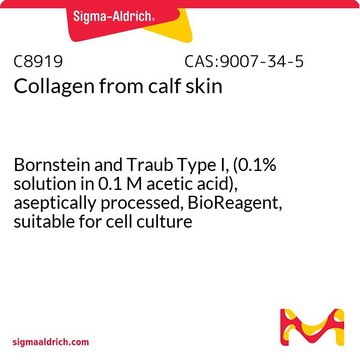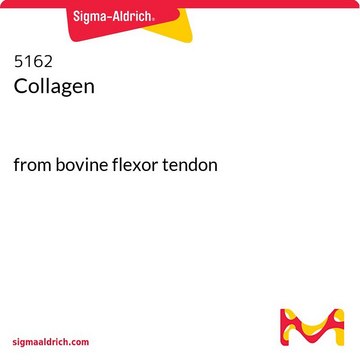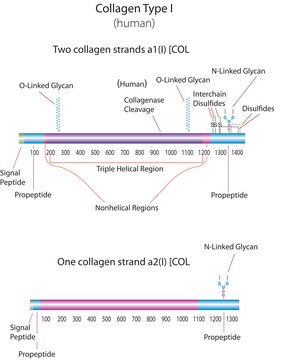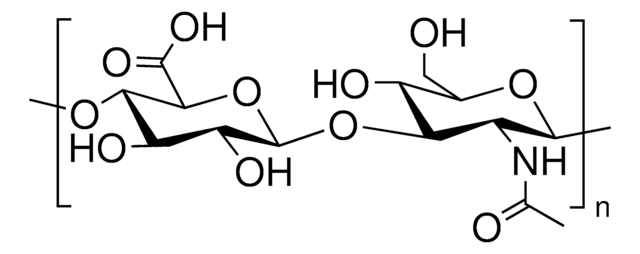C9879
Bovine Collagen Type I
from bovine achilles tendon, powder, suitable for substrate for collagenase
Synonym(s):
Collagen powder
About This Item
Recommended Products
Product Name
Collagen from bovine achilles tendon, powder, suitable for substrate for collagenase
biological source
bovine Achilles tendon
Quality Level
form
powder
technique(s)
ELISA: suitable
activity assay: suitable
suitability
suitable for substrate for collagenase
UniProt accession no.
storage temp.
2-8°C
Looking for similar products? Visit Product Comparison Guide
General description
Application
- the detection of collagenase activity
- as a reference sample in the thermal analysis study of human bone using differential scanning calorimetry, thermogravimetry, gas chromatography and Fourier transform infrared spectroscopy
- as a substrate for developing a simple assay for determining collagen degradation in vitro
- a study to examine the binding activity of the integral glycoprotein dipeptidyl peptidase IV to insoluble type I collagen by solid-phase enzyme-linked immunosorbent assay
Biochem/physiol Actions
Preparation Note
Reconstitution
Storage Class Code
11 - Combustible Solids
WGK
WGK 1
Flash Point(F)
Not applicable
Flash Point(C)
Not applicable
Personal Protective Equipment
Choose from one of the most recent versions:
Certificates of Analysis (COA)
Don't see the Right Version?
If you require a particular version, you can look up a specific certificate by the Lot or Batch number.
Already Own This Product?
Find documentation for the products that you have recently purchased in the Document Library.
Which document(s) contains shelf-life or expiration date information for a given product?
If available for a given product, the recommended re-test date or the expiration date can be found on the Certificate of Analysis.
How do I get lot-specific information or a Certificate of Analysis?
The lot specific COA document can be found by entering the lot number above under the "Documents" section.
How do I find price and availability?
There are several ways to find pricing and availability for our products. Once you log onto our website, you will find the price and availability displayed on the product detail page. You can contact any of our Customer Sales and Service offices to receive a quote. USA customers: 1-800-325-3010 or view local office numbers.
What is the Department of Transportation shipping information for this product?
Transportation information can be found in Section 14 of the product's (M)SDS.To access the shipping information for this material, use the link on the product detail page for the product.
How should Product No. C9879, Collagen from bovine, be reconstituted?
This product is an insoluble collagen preparation. It is insoluble in water, aqueous buffers, dilute acid, and organic solvents. A suspension can be prepared in 50 mM TES buffer, pH 7.4 with 0.36 mM calcium chloride, but not a clear solution.
What application can Product No. C9879, Collagen from bovine, be used in?
This product is suitable for use as a substrate for collagenase. It is not suitable for use as an attachment factor in coating glassware.
What is the structure of the Collagen from bovine - C9879?
The amino acid sequence of the primary structure is mainly a repeating motif with glycine in every third position, and a proline or 4-hydroxyproline frequently preceding the glycine residue.
What is the molecular weight of product C9879, Collagen from bovine achilles tendon?
Since product C9879 is an insoluble collagen preparation, it is difficult to make any kind of molecular weight determination. However, based on the reported structure of this collagen, the expected molecular weight would be approximately 300 kDa.
My question is not addressed here, how can I contact Technical Service for assistance?
Ask a Scientist here.
Our team of scientists has experience in all areas of research including Life Science, Material Science, Chemical Synthesis, Chromatography, Analytical and many others.
Contact Technical Service